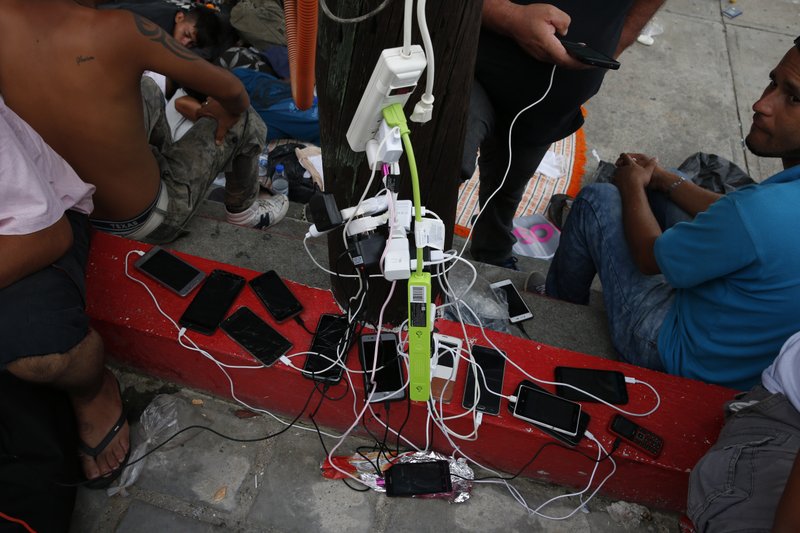SAN SALVADOR, El Salvador -- "When does the next caravan leave?" "Can I go? I'm from Guatemala." "What papers do I need for my kids?"
The questions pile up on the phones of hundreds of Central Americans, all with the same goal: Get as many details as possible before leaving their country.
Costly phone calls with relatives and friends in the United States to work out the route or find the best smuggler are a thing of the past for many Central Americans. Now would-be migrants create chat groups and organize using social media to leave in caravans.
"The social networks have had an empowering role in this new way of migrating," said Abbdel Camargo, an anthropologist at the College of the Southern Border in Mexico. "They organize themselves en masse in their home countries, formed by entire families, and the networks serve them as a mechanism for safety and communication throughout the journey."
The roots of the migrant caravan phenomenon began years ago when activists organized processions -- often with a religious theme -- during Holy Week to dramatize the hardships and needs of migrants. A minority of those involved wound up traveling all the way to the U.S. border.
That changed last year: On Oct. 13, hundreds of people walked out of Honduras and as the days passed and they crossed Guatemala, the group grew to more than 7,000. U.S. President Donald Trump seized on the new phenomenon to ramp up his anti-illegal immigration policies.
Since then, and parallel to the usual clandestine migrant flow north, smaller caravans have continued to leave the so-called Northern Triangle of Honduras, El Salvador and Guatemala.
And increasingly they're organized over Facebook and WhatsApp as they try to join together in large groups they hope will make the trip safer, and without having to hide from authorities.
The most recent caravan left the bus station in San Pedro Sula in northern Honduras on April 10, and journalists have been following various online migrant chats since late March.
"Anyone know anything about the caravan leaving on the 10th? They say the mother of all caravans is going," one message said.
In one of the WhatsApp group chats, members give bits of advice: Everyone should take their passports and those thinking of traveling with children or journeying from far away should arrive a day before the caravan leaves. "To take a child you just need a passport and permission if the mother isn't going." "Take a photo with the mother and the baby."
Some chats appear to be created for a set departure date. Others remain active from earlier caravans or with an eye toward future ones. They usually have various administrators who give advice from points on the route. WhatsApp group members' phone numbers are from Honduras, El Salvador, Guatemala, Mexico and even the United States. Friends and relatives provide invitations.
People aren't afraid to ask delicate questions in the chats: "Group, in Mexico can you find someone to take you to the other side?" And suspicions come out: "Don't trust." "Remember that in Mexico there are a lot of kidnappings."
The messages also explore ways to seek protection against the robberies, extortion, kidnappings that have long plagued those crossing Mexico. Some express fear that the gangs have tried to infiltrate: "This dude works with the Zetas, a friend of mine from Olancho told me he knows him and that he's still with them," said someone who posted a photo of the purported criminal.
Attention to the recent caravans soared in late March, when Mexican Interior Secretary Olga Sanchez Cordero met with then-Homeland Security Secretary Kirstjen Nielsen, and without giving details, said that "the mother of all caravans" was forming with more than 20,000 people.
Shortly thereafter, Trump threatened again to close the border with Mexico and suspend aid to El Salvador, Guatemala and Honduras.
While some in the group that left San Pedro Sula referred to it as "the mother of all caravans," it had fewer than 3,000 people when it arrived at the Mexican border.
The caravans often grow when they reach Mexico because other migrants who are already waiting in the border area tend to join. As of mid-April, there were more than 8,000 migrants, including those who left San Pedro Sula on April 10, at various places in the southern state of Chiapas, according to Mexico's National Human Rights Commission.
For those hoping to join, the chats provide information in real time about where to meet up -- "Caravan where are you going?" "We're waiting for you here" -- and also about roadblocks, places in Mexico where visas are being processed or sites where there's been a problem.
Members also upload photos and videos to let their families know where they are and how they're doing.
And though the April 10 caravan is still in southern Mexico, people in some groups talk about forming others: "Another is leaving April 30, Salvadoran friends."
A Section on 04/20/2019

